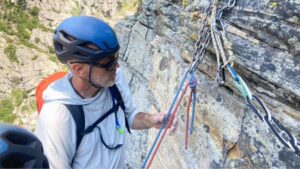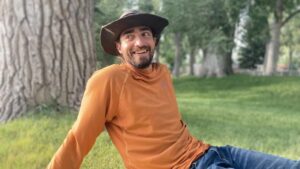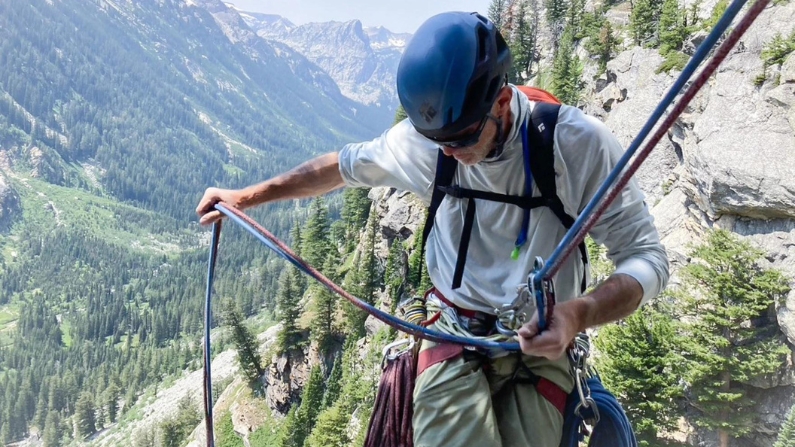It was a blue-sky summer afternoon high up in Grand Teton National Park. Shannon and Garrick Hart stood on a narrow ledge about 800 feet up a jagged rock face.
Garrick, a mountain guide, pointed to a cluster of metal rings — bolts drilled into the granite that have chains hanging off them.
“They kind of blend into the rock,” he said. “You can’t really see them ‘til you’re within like 10 feet of them.”
They’re at the top of Guide’s Wall. It’s a popular first climb in the park, but you can’t safely hike down. So Garrick threaded a rope through those silver bolts.

Garrick Hart makes sure everything looks safe with his rope and fixed anchor before lowering off of Guide’s Wall. He tied two ropes together so he could do a longer rappel. (Hanna Merzbach
/ Wyoming Public Media)
“I’m gonna toss this rope down so that we can rappel down it,” he said, before loudly yelling “rope” to anyone he might hit below.
Next, his wife Shannon used a little device to attach her harness to the rope. It added friction so she can slide down the distance of 15 stories to the next rappel station.
“My carabiner’s locked, my harness is double backed,” she said. “And I just sit back on the rope, let my feet out wide and walk down.”
That day, there was not a cloud in sight. But earlier in their climbing career, the couple remembers a thunderstorm coming out of nowhere and using bolts like these to bail off a route halfway up.
“We were in a waist-deep river of hail in the crack system that we were climbing and we were rappelling as fast as we could to head for shelter,” Garrick recalled.
Fixed anchors like those metal bolts — or slings that go around trees or boulders — have been installed in wilderness areas for decades so climbers can get down safely. But now they’re a major source of controversy.
They technically violate the “Leave No Trace” ethos of the Wilderness Act, which is enforced for other activities like mountain biking. Last fall, the national parks and forest services proposed implementing it for climbing anchors.
Cynthia Hernandez, a spokesperson for the National Park Service, said when the new guidance was proposed, more than 12,000 people wrote in — the majority against it.
“We heard from the climbing community. We heard from parks superintendents,” she said.
The federal agencies say climbing should still be allowed in the wilderness, but drilling holes into rock does damage natural resources. So, they proposed removing anchors.
But Hernandez said land managers could keep ones critical for safety.
“We are just looking to create a draft guidance system that provides a consistent and predictable approach from park to park,” she explained.
Some wilderness advocates support the stricter enforcement, including Franz Camenzind.
“We’re not growing wilderness. It’s shrinking,” Camenzind said, sitting in his living room in Jackson Hole at the foothills of the Tetons.

Franz Camenzind, a retired research biologist and the former leader of Jackson Hole Conservation Alliance, sits on his living room couch. He says he likes to look out his windows at the nature outside every morning. (Hanna Merzbach / Wyoming Public Media)
A towering wall of windows gave a view of a wide creek that bends around the house. Aspen trees and lodgepole pines covered the surrounding green hills.
He thinks humans should leave some things untouched.
“Do we put bridges over, you know, rivers in the wilderness that we would otherwise not be able to cross perhaps?” he asked. “Do we put handrails on traverses on climbing routes because it might not be safe?”
Climbers say even if some anchors are removed, people will still scale rock walls and just leave their own gear behind, or try and climb down without it.
Camenzind said he doesn’t want people to get hurt.
“But if you think you’re in a position where you might get injured, maybe you shouldn’t be there,” he said. “Maybe you should just say ‘This face, this climb, this mountain shouldn’t be climbed.’”
But some climbers disagree.
“There’s no point in preserving it in a pristine condition if we can’t go enjoy it in some way, “ Andrew Lamb said at the International Climbing Festival.
He was a few hours away from the Tetons, having a quiet picnic under some cottonwood trees.

Andrew Lamb, a mountain guide, sits at the City Park in Lander, Wyoming, where the annual International Climbing Festival is based. (Hanna Merzbach / Wyoming Public Media)
He said the proposed regulations aren’t that bad, but he’s worried land managers could be “anti-climbing.”
“I can see the trail and I can see the horse footprints and all the other things that we already allow in wilderness areas and it would be hard for me to be really hard-line about one type of impact over another,” Lamb said.
Neither the U.S. Forest Service or the National Park Service could offer any kind of timeline for a final plan for managing those shiny metal bolts used by climbers.
This story was produced by the Mountain West News Bureau, a collaboration between Wyoming Public Media, Nevada Public Radio, Boise State Public Radio in Idaho, KUNR in Nevada, KUNC in Colorado and KANW in New Mexico, with support from affiliate stations across the region. Funding for the Mountain West News Bureau is provided in part by the Corporation for Public Broadcasting.






